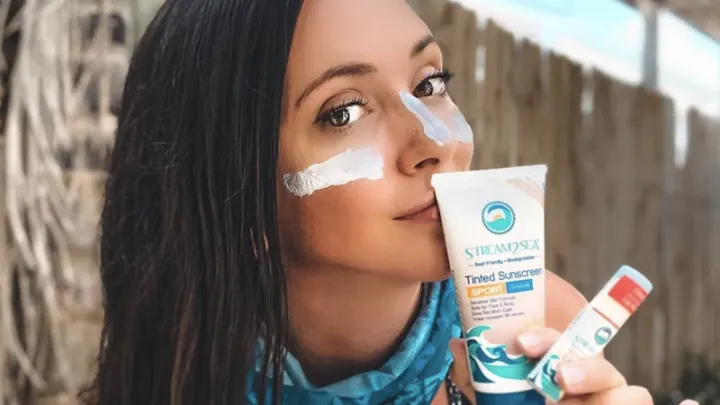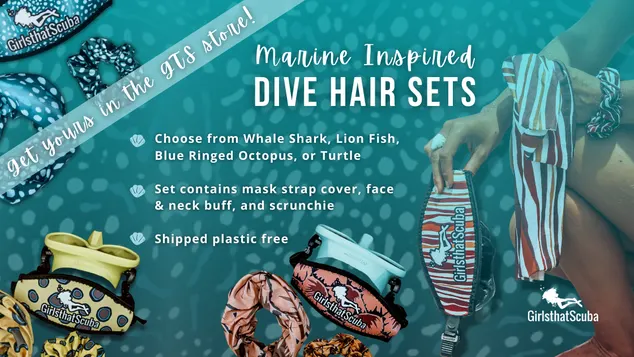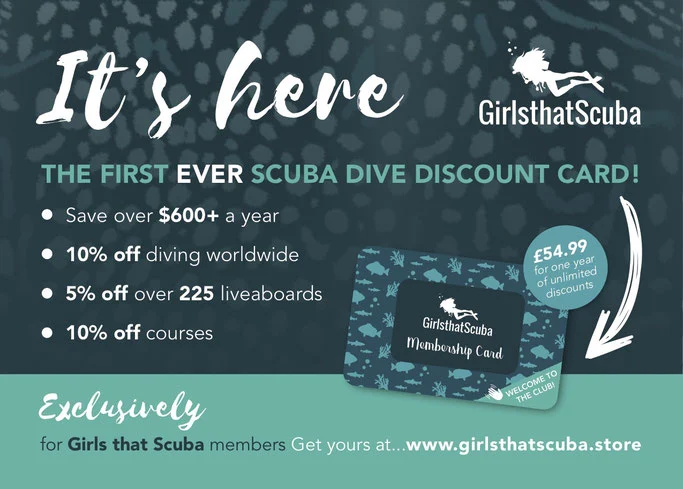With a large proportion of the population becoming ever more eco-conscious (and rightly so), the phrase “reef safe” seems to pop up more and more frequently. Yet we only seem to relate “reef safe” with sun protection – other products in our scuba routines, as well as our everyday product use outside of the water, seem to fall by the wayside and we sometimes have little regard for the other chemicals we’re introducing to our waterways.
As conscious scuba divers it’s easy to become overwhelmed by an eco-guilt when it comes to products, and with a lack of regulation around terms such as “reef safe” and “eco friendly” it’s also a total minefield to know how to do right by our oceans. However, a little knowledge goes a long way to helping us out with this, and we’re here to empower you with that understanding.
In this post we explore why it’s so important that we embrace reef safe products for our oceans, their inhabitants, and ourselves; we’ll provide you with simple suggestions on how to reduce the number of chemicals you’re introducing into the water, as well as explaining exactly which ingredients to look for and which to avoid when it comes to sunscreen. We’ve also included a handy graphic which you can save and check against the ingredients list next time you’re shopping!
What’s wrong with chemical products?
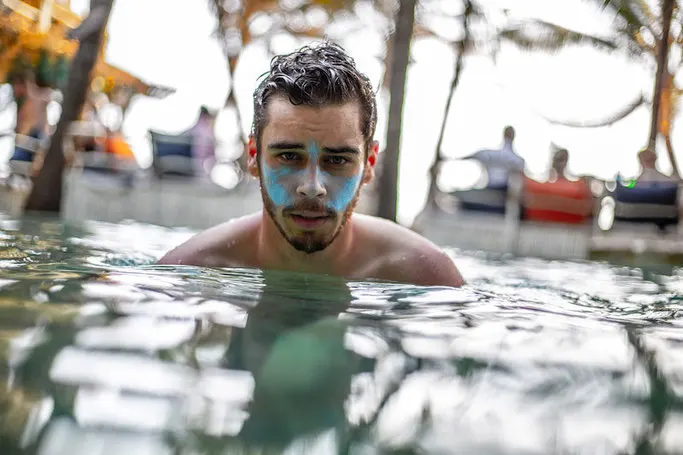
Most people are now fairly aware that rising temperatures in our oceans are a huge contributor to coral bleaching, but do we know how much of an impact our product choices have?
The chemicals in our products seep into water, whether from us directly entering the water with them on our skin or by showering the products off at the end of the day, and the nanoparticles of these chemicals are absorbed by corals and other marine life. These particles then disrupt the growth and reproduction systems of all levels of underwater life; from affecting the photosynthesis of tiny pieces of algae, to decreasing fertility in fish, and of course accelerating the devastating bleaching of our precious coral reefs.
It’s a reminder of the words of the wonderful Sylvia Earle, “no blue, no green” – if we’re starving our corals, killing off plankton, and preventing fish from reproducing, we’ll be having an untold effect on the oxygen levels of our entire planet.
If this is the impact these ingredients and chemicals are having on our ocean’s inhabitants, it only makes sense that they have a similar effect on our bodies. Many of the standard ingredients found in our bathroom cupboards, particularly in sunscreen, were approved for use years ago and were not tested as strictly as they would be nowadays. Whilst they’ve become commonplace, in recent years some of these chemicals have been discovered to have damaging effects on our bodies, even as far as disrupting our hormonal systems and perhaps being carcinogenic (cancer-causing). To read more on the scientific explanation, check out this article from Environmental Working Group.
Switching it up for more environmentally friendly alternatives usually means swapping these questionable chemicals for mineral-based ingredients, and these minerals generally don’t absorb into the skin to be able to cause damage. So not only are you doing better by the planet, you’re doing better by your body too!
It’s not just about sunscreen
Most of us scuba divers know that what we put onto our bodies in the morning will end up in the water and so we become extra conscious of this when we’re actively diving every single day. But do we always remember to carry these good habits into our everyday life? All of our waterways are connected – in one way or another, every product you place on your skin will ultimately end up in the water.
It’s so easy to become overwhelmed by this and feel pressured to pore over every single ingredients list, but by simply knowing which products may be the culprit you’re already a few steps ahead. Try slowly transitioning the following everyday self-care products over to a more natural alternative and you’ll be paving the way for reef-saving divers everywhere!
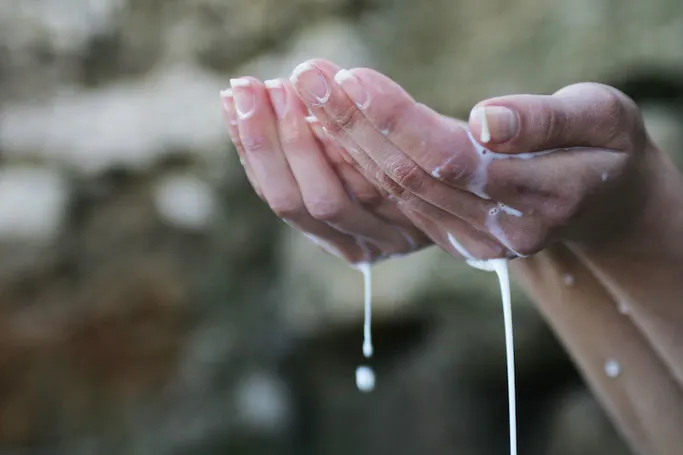
Facial moisturisers often contain sun protection, so check yours against our reef-friendly ingredients list below to ensure it doesn’t contain any of the culprits.
Hair products designed to protect us from the sun can also have these properties – those of us who live out our mermaid dreams by adding fun colours understandably want to retain the colour, but try to opt for more natural dyes in order to lower your impact. Read on further for more tips to protect your hair!
Exfoliating products for both body and face can often contain micro-plastics which we know are extremely damaging to marine environments. Switch for natural exfoliants such as sugar or salt.
Deodorants don’t specifically cause damage to reefs, but mainstream ones can often contain nano-particles of their chemical ingredients which can be absorbed. Look for natural deodorants.
Reducing our product use
The simplest way to ensure we’re doing the best we can for our reef health is simply to reduce our use of chemical products in the first place. However, we know that it’s still super important to protect ourselves from the sun on a long day of diving. So rather than slathering on the sunscreen and leave-in conditioner and allowing it to seep into the water on your next dive, here’s our recommendations for how to protect your skin from the sun and your hair from the water!
Wear your sun protection
Choose to wear your sun protection rather than smothering it on to your skin. Look for clothing which has “UPF” – meaning Ultraviolet Protection Factor – and a rating of at least 50 UPF. Check out SlipIns amazing line of sun protective swimwear; perfect for underneath your wetsuit or worn alone, and GTS membership card holders get an exclusive discount.
By covering most of your body with clothing, you’ll reduce the need for tediously applying sunscreen to your full arms, legs and torso, and only need it for your hands and face. Remember to also add a hat to protect your face, and ensure your sunglasses have UV protection.
Seek shade
As tempting as it might be to lounge on the sundeck to warm up during your surface interval ( Read here if you are interested in knowing how to stay warm when diving), try to stay out of the sun during the hottest part of the day when the sun is strongest (between 10am and 2pm).
Protect your hair
For those of us with longer hair, it’s a constant battle to prevent it becoming damaged from the chlorine and salt exposure of scuba diving. Wetting your hair with fresh water before a dive will soak the cuticle of the hair, preventing it from absorbing so much salt and drying out. Braiding it and using a hair buff can also offer some protection, but if you still need a product option Stream2Sea make a great reef-friendly leave in conditioner.
Which ingredients and products should I be using?
With the terms “reef safe” and “eco friendly” being so unregulated, we can’t trust the front of the packaging to make sure we’re truly using “green” products. Next time you’re looking for a new sunscreen, moisturiser, or hair protecting product, take a few minutes to check your ingredients list against our handy checklist here – you can save this image and we’d love for you to share it with friends to spread the reef-safe knowledge, too!
It’s difficult to list every ingredient which has the potential to be damaging, so remember that simpler formulas (i.e. less ingredients) are generally likely to be more eco-friendly, and that zinc oxide and titanium oxide should always be non-nano in order to be reef safe.
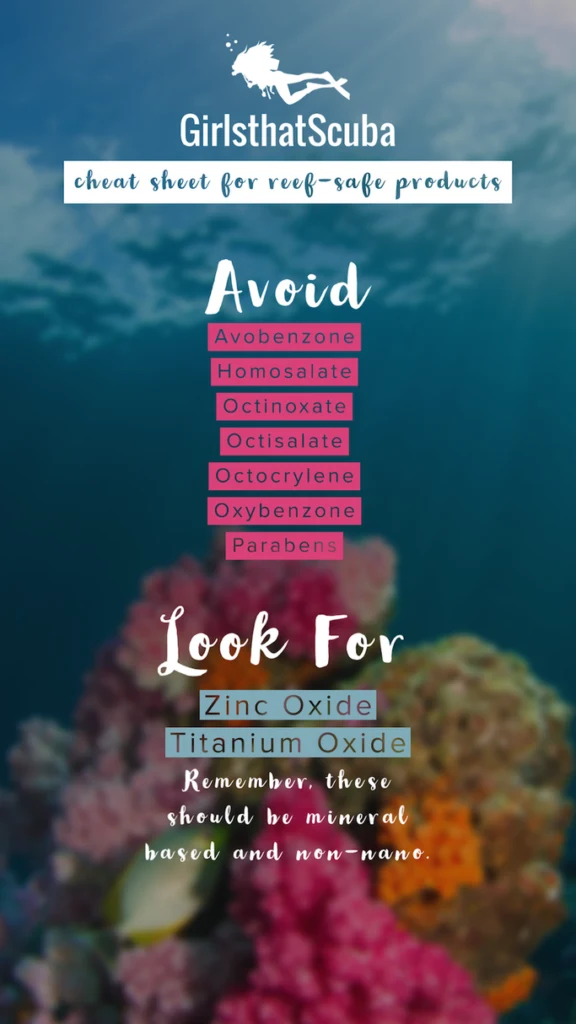
Once you’ve found a reef safe brand you love, stick with it. Voting with your money and supporting eco-friendly brands is one small way we can encourage more mainstream brands to move away from the damaging ingredients they’re using. Some of our favourite reef-friendly brands are All Good (North America), Raw Elements (North America), SunButters Ocean (Australia) and Stream2Sea (US based, ships worldwide).
As Girls that Scuba is such a global community we’ve tried to list a variety of brands here which can be shipped to locations around the world, but we know that product offerings can vary hugely from place to place. If you’re struggling to locate a reef-friendly sunscreen at home or in your holiday destination, always remember to check your local dive store as it’s in their best interest to stock reef-safe products and keep their local marine environment healthy!
Remember, as scuba divers we’re much more conscious of the importance of this issue than our non-bubble-blowing pals, so spread the message by sharing our ingredients list graphic, sending this article to a budding eco-warrior friend, or even gifting a reef-safe alternative product to a family member who’s heading off on holiday.
What products have you ditched or changes have you made in order to help our oceans? Let us know in the comments below, and share your favourite reef-safe sunscreen recommendations with our Facebook group or on Instagram @girlsthatscuba!
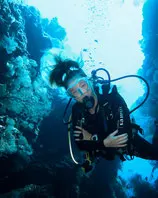
About the author – our GTS blogger Lauren
Lauren originally learned to dive in 2008, and her heart has been in the ocean ever since. In 2018 her sense of adventure and passion for the underwater world led her to Indonesia, where she completed her PADI Divemaster and Instructor qualifications. You can find her on Instagram @laurenelizabethexplores to follow where the currents take her next!

